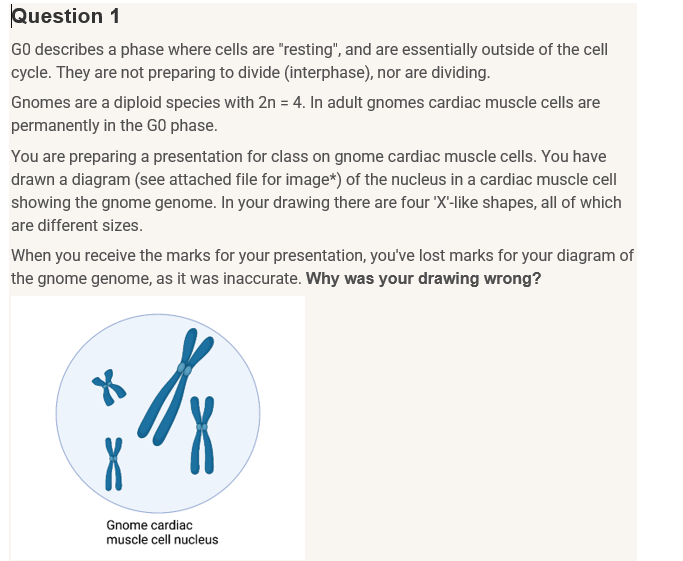Question 1 GO describes a phase where cells are "resting", and are essentially outside of the cell cycle. They are not preparing to divide (interphase), nor are dividing. Gnomes are a diploid species with 2n = 4. In adult gnomes cardiac muscle cells are permanently in the GO phase. You are preparing a presentation for class on gnome cardiac muscle cells. You have drawn a diagram (see attached file for image*) of the nucleus in a cardiac muscle cell showing the gnome genome. In your drawing there are four 'X'-like shapes, all of which are different sizes. When you receive the marks for your presentation, you've lost marks for your diagram of the gnome genome, as it was inaccurate. Why was your drawing wrong? 18 Gnome cardiac muscle cell nucleus
Question 1 GO describes a phase where cells are "resting", and are essentially outside of the cell cycle. They are not preparing to divide (interphase), nor are dividing. Gnomes are a diploid species with 2n = 4. In adult gnomes cardiac muscle cells are permanently in the GO phase. You are preparing a presentation for class on gnome cardiac muscle cells. You have drawn a diagram (see attached file for image*) of the nucleus in a cardiac muscle cell showing the gnome genome. In your drawing there are four 'X'-like shapes, all of which are different sizes. When you receive the marks for your presentation, you've lost marks for your diagram of the gnome genome, as it was inaccurate. Why was your drawing wrong? 18 Gnome cardiac muscle cell nucleus
Human Anatomy & Physiology (11th Edition)
11th Edition
ISBN:9780134580999
Author:Elaine N. Marieb, Katja N. Hoehn
Publisher:Elaine N. Marieb, Katja N. Hoehn
Chapter1: The Human Body: An Orientation
Section: Chapter Questions
Problem 1RQ: The correct sequence of levels forming the structural hierarchy is A. (a) organ, organ system,...
Related questions
Topic Video
Question

Transcribed Image Text:Question 1
GO describes a phase where cells are "resting", and are essentially outside of the cell
cycle. They are not preparing to divide (interphase), nor are dividing.
Gnomes are a diploid species with 2n = 4. In adult gnomes cardiac muscle cells are
permanently in the GO phase.
You are preparing a presentation for class on gnome cardiac muscle cells. You have
drawn a diagram (see attached file for image*) of the nucleus in a cardiac muscle cell
showing the gnome genome. In your drawing there are four 'X'-like shapes, all of which
are different sizes.
When you receive the marks for your presentation, you've lost marks for your diagram of
the gnome genome, as it was inaccurate. Why was your drawing wrong?
X
18
Gnome cardiac
muscle cell nucleus
Expert Solution
This question has been solved!
Explore an expertly crafted, step-by-step solution for a thorough understanding of key concepts.
Step by step
Solved in 2 steps

Knowledge Booster
Learn more about
Need a deep-dive on the concept behind this application? Look no further. Learn more about this topic, biology and related others by exploring similar questions and additional content below.Recommended textbooks for you

Human Anatomy & Physiology (11th Edition)
Biology
ISBN:
9780134580999
Author:
Elaine N. Marieb, Katja N. Hoehn
Publisher:
PEARSON

Biology 2e
Biology
ISBN:
9781947172517
Author:
Matthew Douglas, Jung Choi, Mary Ann Clark
Publisher:
OpenStax

Anatomy & Physiology
Biology
ISBN:
9781259398629
Author:
McKinley, Michael P., O'loughlin, Valerie Dean, Bidle, Theresa Stouter
Publisher:
Mcgraw Hill Education,

Human Anatomy & Physiology (11th Edition)
Biology
ISBN:
9780134580999
Author:
Elaine N. Marieb, Katja N. Hoehn
Publisher:
PEARSON

Biology 2e
Biology
ISBN:
9781947172517
Author:
Matthew Douglas, Jung Choi, Mary Ann Clark
Publisher:
OpenStax

Anatomy & Physiology
Biology
ISBN:
9781259398629
Author:
McKinley, Michael P., O'loughlin, Valerie Dean, Bidle, Theresa Stouter
Publisher:
Mcgraw Hill Education,

Molecular Biology of the Cell (Sixth Edition)
Biology
ISBN:
9780815344322
Author:
Bruce Alberts, Alexander D. Johnson, Julian Lewis, David Morgan, Martin Raff, Keith Roberts, Peter Walter
Publisher:
W. W. Norton & Company

Laboratory Manual For Human Anatomy & Physiology
Biology
ISBN:
9781260159363
Author:
Martin, Terry R., Prentice-craver, Cynthia
Publisher:
McGraw-Hill Publishing Co.

Inquiry Into Life (16th Edition)
Biology
ISBN:
9781260231700
Author:
Sylvia S. Mader, Michael Windelspecht
Publisher:
McGraw Hill Education